Geometry | Term 2 Chapter 4 | 7th Maths - Congruency of Triangles | 7th Maths : Term 2 Unit 4 : Geometry
Chapter: 7th Maths : Term 2 Unit 4 : Geometry
Congruency of Triangles
Congruency of Triangles
We are now going to learn a very important
geometrical concept called congruence. To understand
the concept of congruency of triangles, let us first look into the congruency of
shapes.
1. Congruency of Shapes
Let us observe the following pictures.
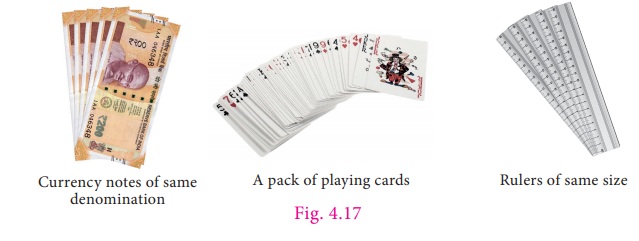
To understand congruency of shapes, let
us take a pack of cards and choose any two cards and place them one over the other.
We are able to place them in such a way that one card matches exactly with the other
in size and shape. Hence all the cards in a pack are equal in both size and shape.
Any pair or set of objects with this
property are said to be congruent.
How can we check the congruence
of two objects or figures?
To check the congruence of the objects,
we can use the method of superposition. In this method we have to make a trace-copy
of one figure and place it over the other. If the figures match each other completely
then, they are said to be congruent. In this method to match the original with the
trace copy, we are not allowed to bend, twist or stretch, but we can translate or
rotate.
2. Congruence of Line Segments
Measure and observe the following line
segments.
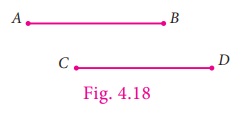
The line segments ![]() and
and ![]() have the same length. If we use the superposition method
have the same length. If we use the superposition method ![]() and
and ![]() will match each other. Hence the line segments are congruent and we can write it
as
will match each other. Hence the line segments are congruent and we can write it
as ![]() ≈
≈ ![]() .
.
Since we are considering the lengths
of the line segments for congruence we can also write ![]() ≈
≈ ![]() as
as ![]() =
= ![]() .
.
From the above cases, we understand that
lines are congruent if they have the same length.
Try these
Measure and group the pair
of congruent line segments.


3. Congruence of Angles
Look at the following angles.
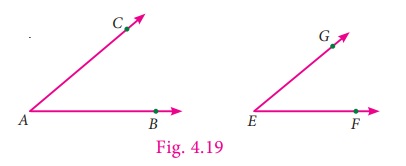
To check the congruency of angles ∠BAC and ∠FEG , make a trace copy of ∠BAC . By superposition method, if we try
to match ∠BAC with the ∠FEG by placing the arm AB on the
arm EF, then the arm AC will coincide with the arm EG. Even
if length of the arms are different, the angles ∠BAC matches exactly with ∠FEG . Hence the angles are congruent.
If two angles ( ∠BAC and ∠FEG ) are congruent, it can be represented
as ∠BAC ≡
∠FEG .
As in the case of line segments, congruence
of angles depends only on the measures of the angles. So if we want to say two angles
are congruent, the measures of the angles should be equal.
Hence we can write ∠BAC = ∠FEG for ∠BAC ≡ ∠FEG.
Try these
Find the pairs of congruent
angles either by superposition method or by measuring them.
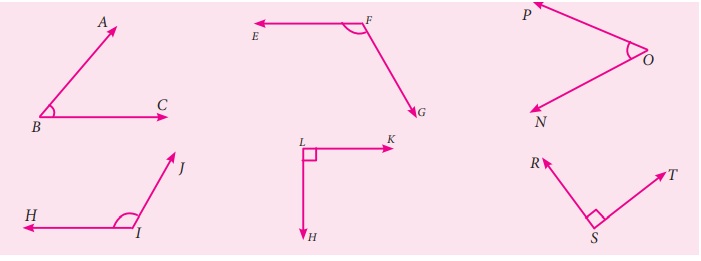
Answer:
∠ABC ≈ ∠PON
∠EFG ≈ ∠HIJ
∠HLK ≈ ∠RST
4. Congruence of Plane Figures
Examine the following pairs of plane
figures.
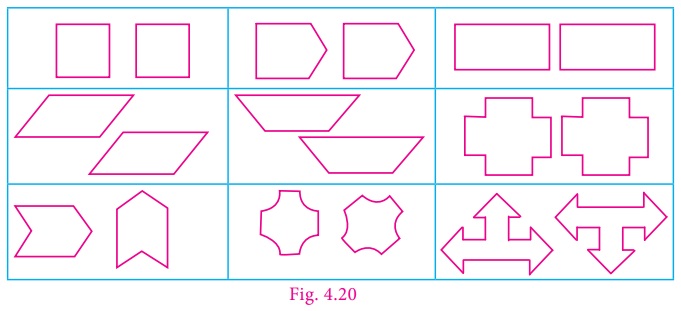
They are identical in shape and size.
Their sides (line segments) are equal and the angles are also equal.
Observe the circles given in Fig. 4.21.
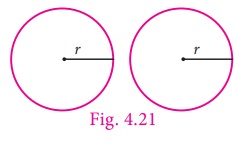
Their radii are equal. If they are placed
on each other they will coincide. These types of figures are called congruent plane
figures.
Note
In congruency, the coinciding
parts are called corresponding parts. The coinciding sides are called corresponding
sides and the coinciding angles are called corresponding angles.
So, if the corresponding sides and corresponding
angles of two plane figures are equal then they are called congruent figures. If
two plane figures F1 and F2 are congruent, we
can write F1 = F2
5. Congruence of Triangles
Triangle is a closed figure formed by
three line segments. There are three sides and three angles. If the corresponding
sides and corresponding angles of two triangles are equal, then the two triangles
are said to be congruent to each other.
Observe the following two triangles ∆ABC and ∆XYZ .
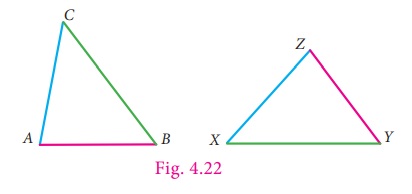
By trace copy superposition method, it
can be observed that ∆XYZ matches identically with ∆ABC.
All the sides and the angles of ∆ABC are equal to the corresponding sides
and angles of ∆XYZ . So we can say the two triangles are
congruent. We can express it as ∆ABC ≡
∆XYZ .
We can also observe that the vertex A
matches with vertex Z, B matches with Y and C matches
with X. They are called corresponding vertices.
The side AB matches YZ,
BC matches XY and CA matches ZX. These pairs are called
corresponding sides.
Also, ∠A = ∠Z , ∠B = ∠Y and ∠C = ∠X . These pairs are called corresponding angles.
In the above case, the correspondance
is A ↔ Z, B ↔ Y, C ↔
X. We write this as ABC ↔ XYZ.
Suppose we try to match vertex A
with vertex Y or vertex X (Fig. 4.23), we can observe that the triangles
do not match each other.
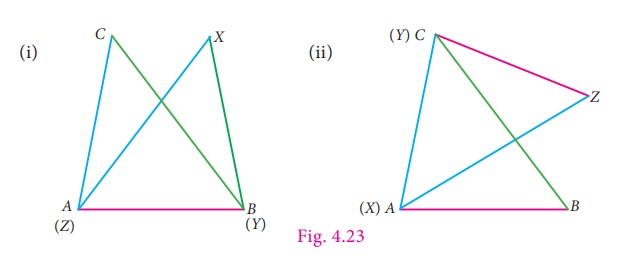
This does not imply that the two triangles
are not congruent.
So to confirm the congruency of given
two triangles, we have to check the congruency of corresponding sides and corresponding
angles.
Hence, the
above triangles ∆ABC
≡
∆XYZ are congruent.
So, we conclude that, if all the sides
and all the angles of one triangle are equal to the corresponding sides and angles
of another triangle, then the two triangles are congruent to each other.
6. Conditions for Triangles to be Congruent
We learnt to check the congruency of triangles by superposition method. Let us check the congruency of triangles using appropriate measures which will be very useful. We can study them as criterions to check the congruency of triangles.
Look at the following triangle (Fig.
4.24).

To draw a triangle congruent to the given
triangle do we need to know all measures of sides and angles of the triangle?
To construct a triangle, we need only
three measures.
Those three measures can be any of the following.
1. The lengths
of all three sides. (or)
2. The lengths
of two sides and the angle included between those two sides. (or)
3. Two angles and the length of the side
included by angles.
We can try the above conditions one by
one.
1. Side–Side–Side congruence criterion
(SSS) - The lengths of all three sides are given
Draw a triangle XYZ given that XY = 6 cm, YZ
= 5.5 cm and ZX = 5 cm
Step 1: Draw a line. Mark X
and Y on the line such that XY = 6
cm

Step 2: With X as centre, draw an arc
of radius 5 cm above the line XY.

Step 3: With Y as centre, draw an arc
of radius 5.5 cm to intersect arc drawn in step 2. Mark the point of intersection
as Z.
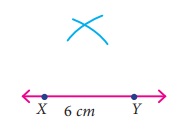
Step 4: Join XZ and YZ.
Now XYZ is the required triangle.
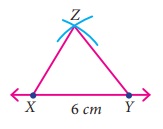
Using trace copy superposition method,
if we place the ∆XYZ on the ∆PQR (Fig. 4.24) in such a way that the sides
PQ on XY, PR on XZ and QR on YZ, then
both the triangles (∆XYZ and ∆PQR) matches exactly in size and shape.
Here we used only sides to check the
congruence of the triangles, so we can say the condition as, if three sides of one
triangle are equal to the corresponding sides of the other triangle then the two
triangles are congruent. This criterion of congruency is known as Side – Side –
Side.
Note
It two triangles are congruent
then their corresponding parts are congruent. We can say “Corresponding Parts of
Congruent Triangles are Congruent”. It can be abbreviated as CPCTC.
2. Side-Angle-Side congruence criterion
(SAS) - The lengths of two sides and the angle included between the two sides are
given.
Draw a triangle ABC
given that AB = 6 cm, AC = 5 cm and ∠A = 60º
Step 1: Draw a line. Mark A
and B on the line such that AB = 6
cm

Step 2: At A, draw a ray AX making
an angle of 60° with AB.
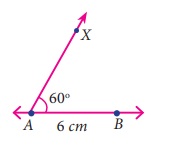
Step 3: With A as centre, draw an arc
of radius 5 cm to cut the ray AX. Mark the point of intersection as
C.
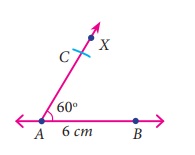
Step 4: Join BC.

ABC is the required triangle.
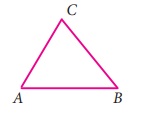
Using trace copy superposition method,
if we place the ∆ABC on the ∆PQR (Fig. 4.24) in such a way that the sides
AB on PQ, AC on PR and the ∠ A on ∠ P, then both the triangles (∆ABC and ∆PQR) matches exactly in size and shape.
Here, we are using only two sides and one included angle to check the congruence
of triangles.
So we can say, if two sides and the included
angle of a triangle are equal to the corresponding two sides and the included angle
of another triangle, then the two triangles are congruent to each other.
This criterion is called Side – Angle
– Side.
3.
Angle – Side – Angle congruence criterion
(ASA) - Two angles and the length of a side included by the angles are given.
Draw a triangle LMN
given that LM = 5.5 cm, ∠M = 70º and ∠L = 50º .
Step 1: Draw a line. Mark L
and M on the line such that LM = 5.5 cm.

Step 2: At L, draw a ray LX making
an angle of 50° with LM.
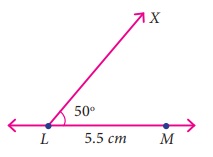
Step 3: At M, draw another ray
MY making an angle of 70° with LM. Mark the point of intersection
of the rays LX and MY as N.
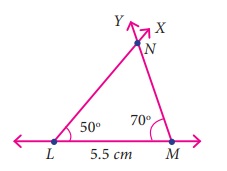
LMN is the required triangle.
Using trace copy superposition method,
if we place the ∆LMN on the ∆PQR (Fig. 4.24) in such a way that the angles
∠L on ∠Q, ∠M on ∠R and the side LM on QR,
then both the triangles (∆LMN and ∆PQR) matches exactly in size and shape.
Here, we used only two angles and one included side to check the congruence of triangles.
Therefore, we can say, if two angles
and the included side of one triangle are congruent to the corresponding parts of
another triangle, then the two triangles are congruent. This criterion is called
Angle – Side – Angle criterion.
Note
There is one more criterion
to check the congruency of triangle. This criterion is called Angle– Angle – Side
criterion which is a slight modification of ASA criterion. In this criterion the
congruent side is not included between the congruent angles. So we can say, if two
angles and a non-included side of one triangle are congruent to the corresponding
parts of another triangle, then also the triangles are congruent.
Hypotenuse
In earlier class we learnt about right
angled triangle. In a right angled triangle, one angle is a right angle and other
angles are acute angles.
Observe the following right angled triangles.

In all the given triangles the side which
is opposite to the right angle is the largest side called Hypotenuse.
In the above triangles the sides AC,
QR and MN are the hypotenuse. Remember that hypotenuse is related
with right angled triangles only.
4. Right Angle – Hypotenuse – Side congruence
criterion (RHS)
The name of the criterion clearly states
that this criterion is used with right angled triangles only.
Observe the two given right angled triangles.
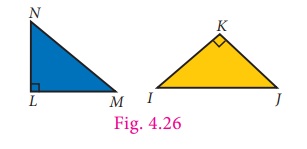
In these two triangles right angle is
common. And if we are given the sides making right angles then we can use the SAS
criterion to check the congruency of the triangles.
Or if we are given one side containing
right angle and hypotenuse, then we can have new criterion, if the hypotenuse and
one side of a right angled triangle is equal to the hypotenuse and one side of another
right angled triangle then the two right angled triangles are congruent.
This is called Right angle – Hypotenuse
– Side criterion.
Note
We learnt the congruency
criterions of triangles. The following ordered combinations of measurement of triangles
will not be sufficient to prove congruency of triangles.
Angle–Angle–Angle (AAA)
combination will not always prove triangles congruent. This combination will give triangles of same shape but not of same
size.
Side–Side–Angle (or) Angle–Side–Side
(SSA or ASS) combination also will not prove congruency of triangles. This combination
deals with two sides and a non-included angle.
Try these
(i) If ∆ABC ≡ ∆XYZ then list the corresponding sides and corresponding
angles.

Answer: ∠A = ∠X, ∠B = ∠Y, ∠C = ∠X
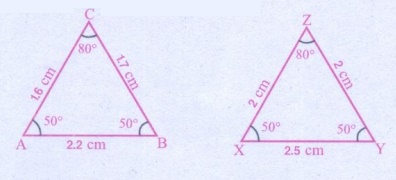
(ii) Given triangles are
congruent. Identify the corresponding parts and write the congruent statement.
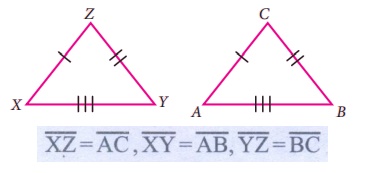
By SSS law, ∆XYZ
≅ ∆ ABC
(iii) Mention the conditions
needed to conclude the congruency of the triangles with reference to the above said
criterions. Give reasons for your answer.

Solution:
∠A = ∠P, ∠B = ∠Q, ∠C = ∠R
By AAA law, ∆ABC ≅ ∆ PQR
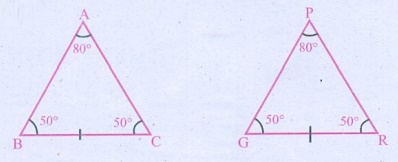
Related Topics